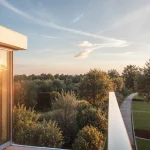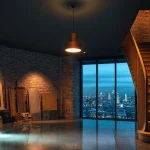Introduction to Barn Conversions
Barn conversions in the UK have become increasingly popular as citizens look to transform these historically agricultural structures into modern, functional living spaces. This trend not only revives old buildings but also merges rustic charm with contemporary living comforts. One of the primary benefits of converting a barn into a home is the unique character and expansive interior space often found in these buildings. Additionally, barn conversions offer a sustainable solution by repurposing existing structures, reducing the need for new construction.
Before embarking on a barn conversion project, there are key factors to consider. Important aspects include assessing whether the barn is suitable for conversion and understanding the potential costs involved. Additionally, prospective renovators need to consider the structural integrity and layout to ensure a successful transformation. The process often requires the expertise of architects and builders familiar with barn renovations to address any structural reinforcements necessary.
This might interest you : Elevate your interiors with elegant georgian ceiling roses
A robust renovation plan and a clear vision for the end result are essential. By carefully evaluating these aspects, you can create a beautiful, unique home that retains the original charm of the barn while providing modern living conveniences.
Planning Permissions and Legal Considerations
When tackling a barn conversion in the UK, understanding the planning permission process is crucial. Many barn conversions require specific permissions due to their unique nature and historical significance. To avoid legal hurdles, applicants should determine if the barn is classified as agricultural or heritage.
Have you seen this : Designing a Vibrant UK Playroom: Inspiring Fun and Learning for Kids with Creative Ideas
Types of permissions vary, but often include:
- Change of Use Permission: Essential when altering the barn’s function from agricultural to residential.
- Listed Building Consent: Required if the barn is a listed structure, protecting its historical significance.
- Building Regulations Approval: Ensures the conversion meets safety and energy efficiency standards.
Navigating local regulations and conservation laws can be daunting. These regulations ensure that barn aesthetics and historical value are maintained while adapting to modern usability. Conservation areas and specific local guidelines often impose additional constraints.
Engaging with local authorities early and understanding property law will streamline the approval process, reducing potential conflicts. Professional consultation with planners or legal experts experienced in property law can provide insights into regional differences and specific requirements, ensuring a smooth transition from concept to reality.
Architectural Considerations
Renovating a barn into a home requires careful attention to its architectural design and structural integrity. These factors ensure the transformed space is both safe and aesthetically pleasing.
Assessing the Barn’s Structure
Begin with a thorough evaluation of the barn’s existing structural integrity. Check the foundation, beams, and roof for weaknesses that might affect the conversion. Identifying areas needing reinforcement with a professional’s help is vital, as their expertise will ensure all necessary repairs are addressed, safeguarding the longevity of the renovated structure.
Design Elements for a Chic Home
Integrating modern design with a barn’s traditional features brings out a unique charm. Emphasize natural elements like wood and stone, complementing them with contemporary lighting and fixtures. Smart use of modern design maximizes natural light, with open spaces bringing the outside indoors, enhancing the overall environment. Eco-friendly materials contribute to sustainability and add a modern touch without detracting from the barn’s character.
Smart Space Utilization
Creating functional layouts is essential when transforming expansive barn layouts into cozy living spaces. Adapt multi-purpose use areas to accommodate different activities seamlessly, including integrated storage solutions that preserve space. Cleverly designed functional layouts ensure the living areas are both practical and inviting while respecting the barn’s original layout.
Interior Design Tips
Creating a stylish living space in a barn conversion involves thoughtful interior design choices that merge function with flair. To maintain the barn’s historical essence while ensuring comfort and modern aesthetics, prioritize choosing a cohesive style that mirrors your personality and suits the unique architecture of the barn. Consider colour schemes and finishes that highlight its rustic appeal, such as earthy tones and natural textures, which blend harmoniously with traditional timber or stonework.
Selecting furniture and decor that complements the barn’s ambience is essential in achieving a balance between old-world charm and contemporary taste. Opt for pieces that contrast or harmonize with exposed beams and stone walls, providing a cosy living space that invites warmth and enjoyment. Incorporating large, comfortable seating and versatile furnishings can enhance the adaptability and functionality of the converted barn, catering to the varied needs of its occupants.
Additionally, integrating ample shelving or built-in solutions for storage maximizes space without imposing on the barn’s open layout, maintaining its spacious allure. By selecting decor that harmoniously blends style with practicality, your barn conversion can transform into a personally unique and stylish home.
Common Challenges in Barn Conversions
Converting a barn into a home is a rewarding venture, yet not without its challenges. Recognizing these potential pitfalls can make the difference between a seamless renovation and a series of unfortunate setbacks.
Identifying Structural Issues
Structural weaknesses in barns often pose challenges. Originally designed for agricultural use, these buildings might have insufficient support for residential conversion. Problems can arise from degraded beams or compromised foundations. Conducting a thorough inspection with a structural engineer identifies these issues early on, allowing for precise solutions.
Solutions for Unexpected Problems
Unexpected issues often surface mid-project. For instance, hidden rot or pest damage can derail timelines. It’s wise to allocate a contingency budget to address these surprises efficiently. Responsive communication between project managers and builders is crucial to timely adjustments, reducing delays.
Project Management and Timelines
Effective project management underpins successful barn conversions. Clear timelines prevent chaotic construction phases, allowing for a smooth transition between tasks. Regularly reviewing progress and maintaining flexibility ensures that adjustments can be made to meet unforeseen obstacles. Assigning a dedicated project manager facilitates cohesive communication and oversight, upholding the overall vision and functionality of the barn conversion.
Recommended Materials for Barn Conversions
Selecting the right building materials is vital for a successful barn conversion, balancing durability and aesthetics while keeping costs manageable. Reclaimed wood offers an attractive option; it adds character and warmth while being sustainable. However, it’s essential to verify its structural integrity and treat it for any pests before use.
Essential Building Materials
- Reclaimed Wood: While charming and eco-friendly, it may require professional assessment to ensure suitability.
- Insulation: Proper insulation is key to enhancing energy efficiency, with materials like sheep wool or hemp proving effective and sustainable.
- Stone and Brick: These traditional materials provide robustness and blend seamlessly with the barn’s rustic aura.
Finishing Touches
Selecting finishes such as flooring is crucial in melding old with new. Consider engineered wood or stone tiles for longevity and style consistency. Fostering the right ambiance with lighting solutions is equally important. Opt for fixtures that complement the character of barn interiors, like wrought iron or antique-style pendant lights. For windows, choosing styles that align with the barn’s heritage ensures a continuity of aesthetic while allowing ample natural light. Always prioritize materials that enhance the ambiance without overshadowing the barn’s unique charm.
Budgeting for Your Barn Conversion
Embarking on a barn conversion demands meticulous budgeting, ensuring that surprise expenses don’t hinder progress. Identifying key expenses such as renovation costs, planning permissions, and structural reinforcements is crucial. Allocating funds for each component helps maintain financial control throughout the project.
Key expenses include labor, materials, and consultation fees with experts like architects. Professional guidance can avert costly mistakes, ensuring the structure’s longevity and compliance with UK regulations. Renovation costs might fluctuate, so incorporating a contingency fund allows flexibility for unforeseen developments.
To manage costs effectively, consider multiple financing options. Traditional loans remain a popular choice, but exploring renovation loans specifically designed for transformation projects might provide terms more suited to your needs. Transparency in contractor agreements can prevent unexpected charges, preserving your budget.
Cost management is crucial in delivering a successful conversion. Regular financial reviews during the project offer clarity on spending and savings opportunities. Engage with financial planning experts to develop strategies that align with your goals, ensuring a tailored approach. By adopting proactive budgeting and considering diverse financing avenues, your barn can be transformed into a cozy living space without financial strain.
Recommended Materials for Barn Conversions
Incorporating the right building materials is essential for a successful barn conversion, as these choices impact both aesthetics and functionality. Reclaimed wood is popular for its rustic charm and sustainability, yet it’s crucial to ensure its quality and safety through professional evaluation before use.
Essential Building Materials
Choosing the appropriate building materials begins with understanding their roles in both the durability and design of the renovation.
- Reclaimed Wood: Offers unique character and an eco-friendly option but should be professionally treated for pests and structural soundness.
- Insulation: Vital for energy efficiency, materials like sheep wool or hemp provide excellent sustainability without sacrificing effectiveness.
- Stone and Brick: These traditional materials offer timeless appeal and strength, complementing the barn’s rustic atmosphere while providing necessary structural support.
Finishing Touches
Focusing on cohesive finishing touches bridges old-world charm with contemporary style. Selecting the right flooring, such as engineered wood or stone tiles, ensures durability and design harmony. Lighting solutions play a pivotal role in ambience; fixtures like wrought iron or antique-style lights add character while catering to the barn’s heritage. Window styles that promote natural light and align with the barn’s essence protect its historical charm while providing modern elegance.
Case Studies and Inspirational Examples
Exploring stunning barn conversions offers valuable insights into transforming agricultural structures into inviting homes. A noteworthy example is a barn in Kent, where a blend of modern design and preservation of natural elements created a harmonious living space. The project emphasized open-plan areas and large windows, allowing plenty of natural light to permeate, accentuating the building’s original character.
A recurring theme in these successful barn conversions is the strategic use of sustainable materials. In a Yorkshire renovation, reclaimed wood sourced locally was employed for its eco-friendly and aesthetic benefits. This choice provided both durability and maintained the barn’s rustic charm, illustrating the balance between innovation and traditional values.
Each project offers distinct design inspiration. For instance, a conversion in Devon integrated smart space solutions, like multi-functional rooms and concealed storage. This approach effectively addressed usage constraints while preserving the barn’s expansive feel.
From these examples, crucial insights emerge: thoughtful integration of modernity with tradition, considering eco-friendly methods, and recognising the importance of architectural and design planning. By learning from these real-life successes, your barn conversion can emerge as a masterpiece that honours its history while embracing contemporary living.










